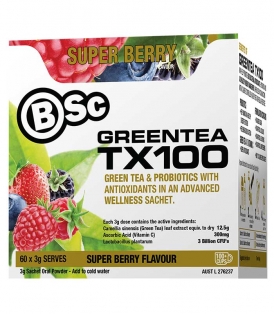Green Tea TX100 Review
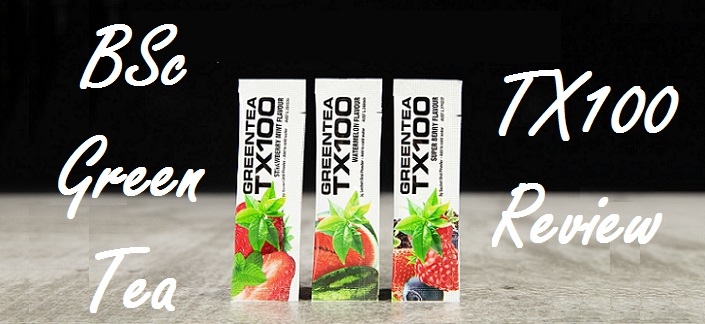
Article by Gavin Deguara, ND, Nutr Med.
TX100 is a Green Tea powder containing Vitamin C and Lactobacillus plantarum probiotic, made with natural sweeteners, colours and flavours that comes in a 3 gram single-serve sachet. Green Tea TX100 is randomly banned-substance tested, and is a vegan and gluten friendly product that Bodyscience outline as a promoter of fat-burning and natural energy.
Despite that fact that the Green Tea market exploded years ago, consumer interest in these antioxidant-rich products has barely waned. The fact that there has been a constant flow of scientific publications released onto the internet for decades now might have something to do with it.
And with these publications comes interest from scientists, healthcare practitioners, researchers, writers, supplement companies and pretty much anyone interested in the benefits that plants and nutrients can deliver.
The miraculous Camellia sinensis plant, from which Green Tea is cultivated, has a lot to offer when it comes to optimising human health and chronic disease prevention.

Green Tea Farm
As the benefits of holistic living are slowly edging their way into the mainstream, the importance of attaining our dream physique, or something close to it, without sacrificing a social life and our health, means that well-marketed natural products like Bodyscience Green Tea TX100 will always have a solid market share.
Green Tea derived caffeine has become a popular ingredient within the wellness industry. Strictly speaking caffeine is caffeine, as far as the body’s responses are concerned, no matter where it comes from. However, Green Tea does offer a range of synergistic nutrients that help to enhance the activity of the caffeine, which will be discussed further in this article.
Plants standardised to a high level of any one single nutrient (or groups of nutrients), like caffeine, does cause concern for some as to just how natural the finished product really is. And of course, a higher level of one nutrient means there will be less others, which are important to the synergism of herbal medicine.
However, adhering to strict principles like these might just lead to the condemnation of practically anything that isn’t pulled straight from the earth by hand and immediately chomped!
In essence, Bodyscience Green Tea TX100 is a concentrated green tea powder containing a slightly higher caffeine content than would be expected for green tea, some Vitamin C and one strain of probiotic, with three flavours to choose from.
These facts alone have put it on the shopping list of many as a natural alternative to coffee, energy drinks and caffeinated soft drink that promotes energy, a more optimistic mood, weight loss and motivation to exercise.
And with some formulation trickery up your sleeve, this product can be used as a solid pre-workout.
Green Tea TX100 Nutrition Information
In terms of calorie and energy values, there isn’t a lot to worry about with this product. Each sachet contains a mere 7 calories (kilocalories) or 29 kilojoules. To burn off 14 calories, found in 2 sachets of BSc Green Tea TX100 calories, you would need to do 1 of the following exercises:
- 80 seconds of Climbing Stairs
- 2 minutes 40 seconds of Playing Ping-Pong
- 60 Seconds of Rope Skipping
- 4 Minutes 10 Seconds Casual Dancing
Undertaking an exercise from this list probably seems like a lot of effort! After all, these sachets are supposed to make life easier, right?
This does drive home an important point: it’s a lot easier to eat and drink calories than it is to burn them off.
Now, if you’re thinking this is far too simplistic, then you’re right. No one person will have exactly the same energy expenditure from a given exercise that involves moving our bodyweight around. And we should also consider the thermogenic effects of the Green Tea catechins and Caffeine, then deduct the total energy expenditure benefit from the energy content of the sachet.

This may very likely lead to an energy or calorie deficit with each sachet consumed.
However, the important take-home point here is calories are tricky to burn off. Replacing some of the highest calorie foods in your diet with some foods richer in micronutrients, with less macronutrient, is always a plus.
Is 14 calories per day worth worrying about? I wouldn’t, especially when those calories come in the form of an antioxidant-rich powder that delivers two proven fat-burners: EGCG and caffeine.
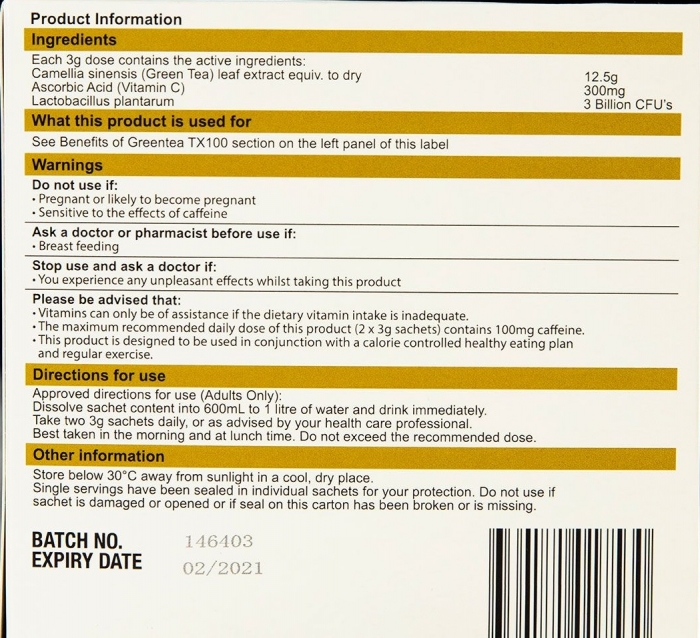
Apart from the energy content, which is mentioned on the Bodyscience home page for this product, under the “Key Info” tab, TX100 doesn’t have a standard nutrition panel, indicating sodium, protein, sugar etc. However, it is stated that this product contains no added sugar.
Of course, there is naturally occurring sugar content in just about everything. Though, worst case scenario, if all 7 calories in each sachet are derived from naturally occurring sugar, perhaps contained within the natural flavours and colours, then the Green Tea TX100 sugar content could be as high as 1.75 grams.
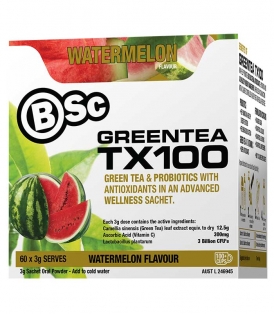 However, part of this calorie content likely comes from the trace macronutrient content of the green tea powder itself.
However, part of this calorie content likely comes from the trace macronutrient content of the green tea powder itself.
Discussing nutritional data can certainly be a bit of a yawn-fest. But it’s worth noting that basic principles like these can be applied to a wide range of supplements, foods and beverages.
The low carbohydrate content of Green Tea TX100 makes it a product that will suit most ketogenic enthusiasts when used up to 2 times daily, which is Bodyscience’s maximum recommended servings.
EGCG—Why The Hulk likes Green Tea
Also known as Epigallocatechin-3-0-Gallate, this is the main polyphenol naturally found in green tea. Not to be confused with an ECG or Electrocardiogram, which tests the electrical activity of the heartbeat.
Though, to digress just a little, there are some similarities. Both EGCG and ECG offer benefits for the heart. While an ECG (also abbreviated EKG) offers insight into heart muscle function and blood flow, regular Green Tea drinking, which contains EGCG, has been shown to offer benefits for the prevention of cardiovascular disease 1.

EGCG is believed to be the main catechin in Green Tea responsible for the improvements seen in energy expenditure. Despite a convincing body of evidence illustrating the beneficial effects of EGCG on the metabolism, most scientists still believe more evidence is required to prove this effect beyond any reasonable doubt.
And this an issue seen time and time again in the wonderful world of natural medicines. Finding scientific interest and, more importantly the funding, for the research required to learn more about how natural products work is not so simple for an unpatentable finished product.
If squillions of dollars can’t be made out of the product once it’s proven to work, then who will invest? After all, we’re only talking about health and longevity, and the prevention of chronic degenerative disease in an aging population …
But that’s another blog article for another day … or year.
Let’s take a look at some of the Green Tea studies undertaken on humans that have been published so far.
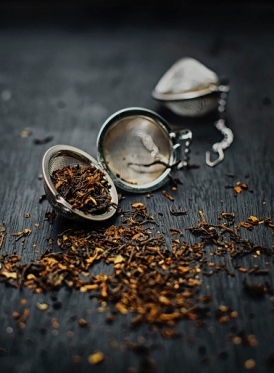
Way back in 1999, if you can remember such a year (and if you were born!), the American Journal of Clinical Nutrition published a piece of research that compared the effects of three treatments: Green Tea Extract (equivalent to 50mg caffeine and 90mg EGCG), 50mg caffeine and placebo 2.
The results showed that Green Tea stimulated fat oxidation more than can be explained by its caffeine content. After all, caffeine is naturally occurring in Green Tea. And it’s a proven sympathetic nervous system stimulant and weight loss aid 3.
And most would immediately assume that it’s the caffeine content of Green Tea alone that makes it a helpful weight loss aid. Research indicates they would be off the mark on this one.
In 2009 The Journal of Nutrition published a research paper by Maki K.C. et al that studied the effects of a Green Tea beverage on abdominal weight loss on an exercise program 4.
The results of this study indicated that Green Tea catechins were able to stimulate more beneficial changes in abdominal fat and serum triglycerides, which is good news for anyone who regularly enjoys this delicious green beverage.
Finally, a meta-analysis published in 2017 by The Journal of Nutritional Biochemistry indicated that EGCG consumption moderately increases energy expenditure, with a suggested daily dosage of 300mg 5.
When it comes to Green Tea and its plethora of unique and interesting phytochemicals, fat loss is merely the tip of the ice-berg lettuce. Some of the other benefits believed to be associated with the regular consumption of this plant are: anti-cancer, anti-viral, anti-bacterial, anti-diabetic, anti-atherosclerotic and much more 6.

These benefits put green tea and its products high on the list for many, particularly those looking for some additional metabolic support during weight loss. Green Tea may also provide benefits for anyone wanting to maintain a healthy bodyweight and support overall health and wellness.
When to Take TX100—Side Effects?
This Green Tea product can be consumed practically anytime of the day or night, provided you’re not too sensitive to the effects of caffeine. If you are unsure of your sensitivity level, try taking ¼ to ½ sachet (12.5-25mg caffeine) before lunch time.
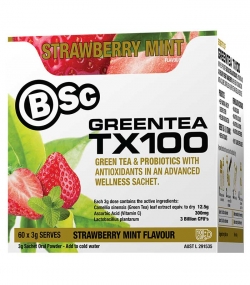 Occasionally, green tea taken on an empty stomach can cause nausea. This is an uncommon side effect of green tea that can typically be managed by reducing the dosage and taking it after a main meal.
Occasionally, green tea taken on an empty stomach can cause nausea. This is an uncommon side effect of green tea that can typically be managed by reducing the dosage and taking it after a main meal.
You may like to take TX100 before exercise to improve your energy level, or throughout the day at a time when you may be reaching for snack food—especially if you work on a computer all day long.
Taking this product too late in the evening or too close to sleep may interfere with a sound night’s sleep, as does any caffeine containing product, food or drink. However, once again, this all depends on your individual caffeine tolerance.
How Many TX100 Sachets per Day?
Bodyscience recommend a maximum of two Green Tea TX100 sachets per day, which will total 50mg of caffeine. In addition, each sachet provides 300mg of vitamin C and a probiotic strain called Lactobacillus plantarum.
Vitamin C is a powerful antioxidant, immune supportive and collagen-supportive nutrient that has been shown to reduce post-exercise inflammation and cortisol, at a dosage of 1,500mg per day 7.
Lactobacillus plantarum certainly is an interesting probiotic addition to TX100. This strain of beneficial bacteria has been used for decades in health promoting products and live cultures.
Research shows that Lactobacillus plantarum has beneficial effects of the immune system and may reduce the risk of cardiovascular disease 8.
How to Create a Natural Pre-Workout with TX100
TX100 makes for a perfect base for anyone keen to take a do-it-yourself approach to natural pre-workouts. BSc Green Tea TX100 provides a solid flavour, caffeine, antioxidant and vitamin C base.

All you need to do is add some other amino acids and nutrients to your liking, depending on what your training and health goals are.
For instance, if you prefer a pre-workout that promotes energy, with thermogenic, stamina and mood enhancing effects, try adding some pure Acetyl-L-Carnitine powder (1.5g) and L-Tyrosine powder (2g) to each serve.
If explosive power and pumps are more your focus, then add some Creatine monohydrate, Betaine (Trimethylglycine) and Glycerol to each serve. Glycerol and Creatine are well known for their ability to not only improve muscle fluid retention during your workout for a great muscle fullness experience, but to also help you retain that pump for longer once the session is finished.
Alternatively, Citrulline Malate, Agmatine Sulfate and Beetroot Nitrates provide solid nutritional support for the nitric oxide pathway. This specifically supports blood flow to muscle tissue, enhances muscle pumps and may improve performance.
Final Verdict
Bodyscience Green Tea TX100 contains a dry leaf equivalency of 12.5 grams of Green Tea per sachet, compared to a regular cup of green tea which is typically brewed from 2 grams of dry leaves.
The caffeine content in each sachet is slightly higher than would be expected from a regular cup of Green Tea, at 50mg per sachet. In addition, Green tea contains a range of beneficial antioxidants, L-theanine and EGCG.
There is a decent body of evidence for caffeine and green tea catechins as increasing energy expenditure. This means more calories are being burned at rest or during activity.
It’s important to note, however, that these fat-burning actions are believed to moderate in their potency. This puts all green tea and green tea related products into the category of “helpful adjuncts” to a weight loss program.
And adjuncts means that exercise and dietary changes are absolutely integral if you want to experience meaningful and long-term improvements in your overall health and body composition.
Importantly, TX100, just like all other formulated weight loss aids, should not be relied upon as a sole approach to weight loss. Despite the fact that Green Tea TX100 is a well formulated and natural product based on a powerful therapeutic plant, the fact remains it won’t be powerful enough to overcome dietary neglect and an absent exercise program.
To finish on a humorous note, here’s a list of activities that shouldn’t be thought of as physical exercise:
- Moving your thumbs around on a PS4 controller
- Watching high-adrenaline action films for hours on end
- Watching people workout on Youtube
- Walking to the pantry for some high-calorie snack food
- Walking around the supermarket with a trolley load of packaged food
- Installing a Gigantic TV in front of an extremely comfortable couch
- Sprinting upstairs to get your chocolate fountain maker
On the other hand, here’s some simple exercise that can be incorporated into everyday life:
- Early morning brisk walk
- Gardening and lawn mowing
- Calisthenics or Yoga
- Tennis, Squash or Table-Tennis
- Aqua Aerobics
- Dancing
- Sweeping, Mopping and Vacuuming
References
- Pang J et al. Green tea consumption and risk of cardiovascular and ischemic related diseases: A meta-analysis. International Journal of Cardiology 2016 Vol 202 p.967-974
- Dulloo A.G. et al. Efficacy of a green tea extract rich in catechin polyphenols and caffeine in increasing 24-h energy expenditure and fat oxidation in humans. American Journal of Clinical Nutrition 1999 Vol 70 p.1040-1045
- Tabrizi R et al. The effects of caffeine intake on weight loss: a systematic review and dos-response meta-analysis of randomized controlled trials. Critical Reviews in Food Science and Nutrition. 2019 Vol 59;16 p.2688-2696
- Maki K.C. et al. Green Tea Catechin Consumption Enhances Exercise-Induced Abdominal Fat Loss in Overweight and Obese Adults. The Journal of Nutrition 2009 Vol 139;2 p.264-270
- Kapoor MP et al. The Journal of Nutritional Biochemistry. 2017 Vol 43 p.1-10
- Suzuki Y et al. Health-Promoting Effects of Green Tea. Proceedings of the Japan Academy, Series B. Physical and Biological Sciences. 2012 Vol 88;3 p.88-101
- Peter E.M., et al. Vitamin C supplementation attenuates the increases in circulating cortisol, adrenaline and anti-inflammatory polypeptides following ultramarathon running. International Journal of Sports Medicine, 2001 Vol 22;7 p.537-543
- Nobre Costa G et al. Potential Fate of Ingested Lactobacillus plantarum and Its Occurrence in Human Feces. Applied and Evironmental Microbiology. 2014 Vol 80;3 p.1013-1019



